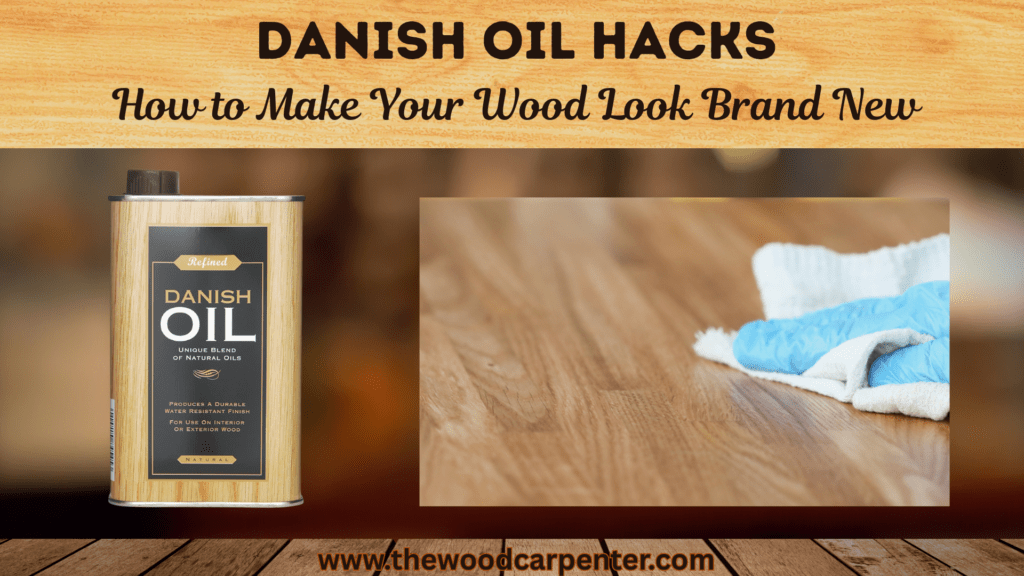
Danish oil is a well-loved wood finish used by woodworkers, DIYers, and homeowners to protect and improve the natural beauty of wood. It combines the deep penetration of natural oils with the strength of varnish, giving a tough, water-resistant surface. It makes the wood grain look richer without creating a shiny, plastic-like coating.
What Is Danish Oil?
Danish oil is a mix of:
- Oils – usually tung oil or boiled linseed oil
- Varnish – such as polyurethane or exterior varnish for extra protection
- Thinner – like mineral spirits or turpentine to help it soak into the wood
Different brands may use slightly different recipes, but most Danish oils contain about one-third varnish and two-thirds oil.
Unlike varnish that stays on the surface, Danish oil soaks deep into the wood. It hardens inside the fibers when it reacts with oxygen in the air — a process called polymerization. This gives the wood a strong, water-resistant, satin finish while keeping its natural look and feel.
The result is a smooth, low-sheen surface (not slippery or overly shiny), making it perfect for things that are touched often, such as:
- Furniture
- Kitchen utensils and counters
- Tool handles
- Cutting boards (if using a food-safe type)
Composition and Characteristics
Oils – Usually tung oil or boiled linseed oil. They soak into the wood, add moisture protection, and keep the wood nourished.
Varnish – Makes the finish tougher, more resistant to scratches, and able to handle spills or chemicals.
Thinner – Mineral spirits or turpentine help the oil soak in better and make it easier to spread.
Hard-drying oil – Once cured, Danish oil forms a strong layer inside the wood that resists water and wear.
Finish – Leaves a smooth satin look that keeps the wood’s natural feel without a thick, shiny layer on top.
Advantages of Danish Oil
Brings Out Wood’s Beauty – Makes the wood’s color richer, highlights the grain, and gives a warm tone without hiding the natural texture.
Water & Stain Resistant – Helps protect against spills from water, coffee, wine, juice, and more.
Long-Lasting – The varnish in it makes the finish tougher than plain oil.
Easy to Use & Maintain – Just wipe or brush it on, wipe off the extra, and reapply when needed.
Safe After Curing – Many Danish oils are safe for use on cutting boards, kitchen tools, and children’s toys once fully cured.
No Peeling or Cracking – Soaks into the wood instead of forming a thick surface layer.
Dries Fairly Fast – Usually dries within 4 to 24 hours depending on temperature and humidity.
Tung Oil vs Danish Oil: A Comprehensive Comparison
Disadvantages of Danish Oil
Not as Tough as Polyurethane – Gives good protection but not as hard or heavy-duty as thick varnish finishes.
Needs Regular Upkeep – May need reapplication over time, especially for items used often or kept outdoors.
Only Works on Bare Wood – Won’t stick to old finishes; wood must be sanded first.
Fire Risk from Rags – Rags soaked in Danish oil can catch fire if left bunched up; lay them flat to dry or soak them in water before throwing away.
Takes Time – Works best with several coats, with drying time in between.
Doesn’t Fill the Grain – Keeps the wood’s natural texture instead of making it perfectly smooth.
Common Uses of Danish Oil
- Furniture (tables, chairs, cabinets)
- Wooden utensils, cutting boards, and kitchen countertops
- Tool handles and wooden toys
- Decorative wooden objects and carvings
- Indoor woodwork and trim
- Some outdoor use on protected or lightly exposed wood (regular reapplication needed)
How to Apply Danish Oil: Step-by-Step Guide
Preparation
Make sure the wood is bare, clean, and dry. Sand it smooth, starting with coarse grit and finishing with fine grit (120–220). Remove all dust with a vacuum or tack cloth.
First Coat
Stir the Danish oil well. Apply a generous amount along the grain using a brush, foam brush, or lint-free cloth. Make sure the wood is fully covered.
SoakingLet the oil soak in for 15–30 minutes. If some areas dry faster, add more oil so the surface stays evenly wet.
Wipe Off Excess
Use a clean cloth to wipe away all extra oil. Buff gently so the surface looks silky, not wet or sticky.
Drying
Leave the wood to dry in a warm, well-ventilated, dust-free space for 4–24 hours, depending on conditions.
Additional Coats
Repeat the same process for 2–3 more coats. For a smoother surface, you can mix Danish oil with fine sanding dust and rub it in (“slurry coat”) to fill the wood pores.
Final Buffing
Once the last coat is dry, buff lightly with very fine sandpaper (600 grit) or fine steel wool for a soft satin look.
Maintenance
Clean with mild soap and water. Reapply Danish oil when the surface starts to lose its shine or protection.
Frequently Asked Questions (FAQs) About Danish Oil
Q: Is Danish oil the same as tung oil or linseed oil?
No. Danish oil is a blend that usually contains tung or linseed oil, varnish, and a thinner. Pure tung or linseed oil has no varnish, so it dries and protects differently.
Q: Can I use Danish oil outdoors?
Yes, but it needs regular care and reapplication. It lasts longer indoors, so for outdoor use you’ll need to maintain it more often.
Q: How many coats should I apply?
Three coats are usually enough for good protection and a nice look. You can add more for heavy-use surfaces.
Q: How long does it take to dry?
Each coat takes 4–24 hours to dry, depending on temperature and humidity. Always let a coat dry fully before adding the next one.
Q: Is it food safe?
Many brands are food- and toy-safe once fully cured, so they’re fine for cutting boards, utensils, and kitchen surfaces.
Read in detail:
Is Danish Oil Food Safe? Everything You Need to Know
Q: Will it make the wood shiny?
No. Danish oil gives a soft satin or low-sheen finish that shows off the wood grain without looking glossy.
Q: How do I safely throw away oily rags?
Lay them flat outside to dry or soak them in water before putting them in the trash. If you don’t, they could catch fire on their own.
Q: Can I put Danish oil over another finish?
It works best on bare wood. It usually won’t stick well to varnish, polyurethane, or other finishes.
Summary
Danish oil is a great choice for wood finishing if you want a warm, natural look with some water resistance and durability. Its mix of oils, varnish, and thinner soaks deep into the wood, protecting it without leaving a thick, plastic-like layer.
It’s perfect for indoor furniture, kitchen items, and decorative pieces, but can also be used outdoors with regular upkeep. It’s easy to apply, easy to maintain, and works well for both beginners and experienced woodworkers.
With the right prep, application, and care, Danish oil can keep your wood looking beautiful for years.

